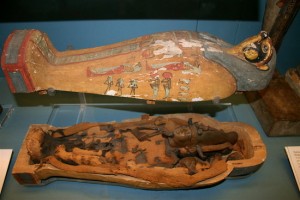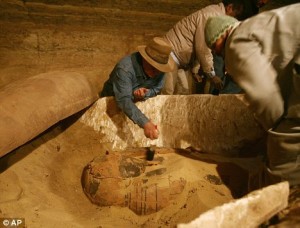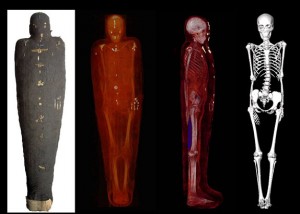What Did Makeup Containers Have To Do With Mummification
Mummification was a procedure undertaken by the ancient Egyptians. They believed that by preserving a trunk, its soul could alive on in the afterlife. Embalmers offered various packages, which included a basic, standard and luxury version.
Fifty-fifty then, it was but the rich that could afford to mummify their dead and thereafter identify them in an elaborate tomb. Ordinary civilians were buried in pit graves, and some of these bodies were naturally dried.
Mummification was an elaborate and lengthy procedure that took 70 days. The violation of the torso was abhorred, and so the offset incision performed on the corpse was made past a 'scapegoat'. He was then ritually stoned and chased from the embalming sleeping accommodation. Afterwards, the intestines, lungs, stomach and liver were removed – these were mummified and placed in special containers called canopic jars. The encephalon was pulverized with a long narrow instrument and drained through the nose or the back of the skull.
The heart, which was then known equally the seat of learning, was left inside the body. During the mummification process the priests would venerate the expressionless; they would low-cal incense, recite prayers and invoke aid and protection from ancient Egyptian gods. One time cleansed, the body was then prepare to be dried.
 The aboriginal Egyptians placed the trunk in natron salts, which captivated all its moisture. After a period of 40 days information technology was removed and packed with herbs, oils and spices, which were known to cleanse and preserve the cavities. If extra body parts were needed the corpse was equipped with imitation wooden limbs, or eyes made of obsidian. It was then ready for bandaging. Each limb was carefully tended to; fingers and toes were treated individually, and golden caps were placed on the nails. In club to protect it, a large number of amulets were left on specific parts of the body. Often, garlands of leaves or berries, which were thought to accept rejuvenating properties, were placed around the cervix. The hair was dressed with oils and jewellery. Due to rut and lice, the ancient Egyptians shaved their heads, so elaborate wigs (made of human hair) were placed on the deceased. Makeup was practical, and it was dressed in fine clothes and adornments. While women were buried with combs and pottery, men were armed with daggers or swords. These were placed either on the body or within the wrappings.
The aboriginal Egyptians placed the trunk in natron salts, which captivated all its moisture. After a period of 40 days information technology was removed and packed with herbs, oils and spices, which were known to cleanse and preserve the cavities. If extra body parts were needed the corpse was equipped with imitation wooden limbs, or eyes made of obsidian. It was then ready for bandaging. Each limb was carefully tended to; fingers and toes were treated individually, and golden caps were placed on the nails. In club to protect it, a large number of amulets were left on specific parts of the body. Often, garlands of leaves or berries, which were thought to accept rejuvenating properties, were placed around the cervix. The hair was dressed with oils and jewellery. Due to rut and lice, the ancient Egyptians shaved their heads, so elaborate wigs (made of human hair) were placed on the deceased. Makeup was practical, and it was dressed in fine clothes and adornments. While women were buried with combs and pottery, men were armed with daggers or swords. These were placed either on the body or within the wrappings.
At the beginning of the 20th Century, Egyptology was in its infancy. Many early excavators ignored human remains. The first archaeologists were more than interested in treasure than mummies, and even the body of Tutankhamun was subjected to trauma. Although Ho ward Carter was a bright excavator, he could not have imagined the wonders that the dead could reveal. Nor did he envisage that innovations in science would enable us to make important new discoveries about aboriginal Egyptian mummies. Despite this, the earth was now fascinated. Even in Victorian times, the unwrapping of an Egyptian mummy (which oftentimes took place in flush drawing rooms) would be followed by tea, cake and polite conversation.
Thankfully, times have inverse and the get-go scientific unwrapping of a mummy took identify in Manchester when Margaret Murray examined the 2 brothers, Khnum-Nakht and Nekht-Ankh, in 1908. Manchester continues its strong clan with the scientific study of mummies. It is here that Professor Rosalie David conducted many innovative investigations into ancient disease. In 1979 she established the International Mummy Database, which employs endoscopy and serological studies, x-ray examinations and MRI scans. Perhaps the most important investigation into ancient mummies was undertaken in Paris between 1976-1977, when the mummy of Ramesses II was met at Orly airport and treated similar a visiting head of state. A team of over 100 scientists, including botanists, microbiologists and anthropologists, worked on his torso and published startling new evidence about mummification techniques.
Examinations that utilize Deoxyribonucleic acid sampling are now used in mummy studies. While the practise is still limited, it tin can enable Egyptologists to identify, found and study family groups. We are now able to shed light on the everyday life of the ancient Egyptians, going on to clarify dental hygiene, hair dyes and makeup. When examining mummies nosotros are now able to written report textiles, jewellery, oils and even caput lice – the oldest 'nits' in the globe were found on a Manchester mummy. From these examinations we can learn a groovy bargain nigh the diseases, afflictions and the general aches and pains of all classes of people, and we can even identify trauma wounds, arthritis and polio. With the invention of new scanning techniques, the destructive process of 'unwrapping' a mummy is now a thing of the past. What remains constant, however, is that mummies continue to fascinate, excite and inspire u.s.a..
Death bedchamber
 We open up the doors to the eerie and mysterious world of the embalming sleeping accommodation, to explain how the process was performed!
We open up the doors to the eerie and mysterious world of the embalming sleeping accommodation, to explain how the process was performed!
Although the House of the Dead was occupied by priests and their servants, it was also regarded as a place of dread. The sight or smell of the embalming chamber was viewed with fear and repulsion. Inside the Firm of the Expressionless, there would frequently be a long queue of bodies waiting to be embalmed; they would be placed on sloping beds then that trunk fluids and blood would drain into vats. Flies, inexperience and heat could make the work difficult. As nosotros have explained, the embalming process was an urgent and bloody activity-when rushed, the embalmers often lost or severed limbs. The morality of the morticians was also regarded with suspicion; they were often associated with robbery and corruption. On the other mitt, morticians were viewed as mystics and magicians, and a sense of secrecy surrounded their art.
Types of natural mummies
Bog bodies – Waterlogged peat holds very little oxygen, and this means that the microorganisms that crusade decomposition cannot survive. The acerbity in the bog, along with sphagnum moss, besides helps to preserve the body. While the skin, hair and internal organs are remarkably well preserved, the bones are softened. The body begins to take on a dark, leathery appearance.
Self-mummification – was practiced past the Sokushinbutsu, a group of Japanese Buddhist monks. For several years, the monks would alive on a nutrition of seeds and nuts and would drink the sap of the Urushi tree, which would cause vomiting and loss of body mass. They would seal themselves in a tomb and die -if the body had mummified, it was regarded as a holy vessel.
Desiccation – When left in the open, water, insects and heat will rapidly destroy the body. If the body buried in sand or salt, wet in the flesh is absorbed and the corpse is preserved. More importantly, in the case of Egyptian mummies the removal of internal organs aids this process, preventing internal bloating and decay.
Ice mummies – Water ice prevents decomposition of the trunk and inhibits the growth of bacteria. It likewise preserves pollen and dust grains. Ice is an excellent and effective agent, so ice mummies seem very lifelike. Their hair, eyelashes and torso decorations are oftentimes astounding. Ice mummies have even been discovered with votive offerings and grave appurtenances.
Mummies around the World
Fact – Water ice mummies – Dated to the Pazryk culture, the Ice Maiden and her contemporaries are dated 6th to 3rd Centuries BC. These mummies were buried with elaborate funerary equipment – in the case of the Ice Maiden, there were half-dozen horses and a symbolic last repast. Her body is covered in a series of beautiful blueish tattoos which describe mythical animals.
Fact – Mummies of the Canary Islands – The Guanche mummies were found on the Canary Islands in the 15th Century, when they were discovered past Spanish invaders. Fiddling is known of them – many were pulverized and used as medicinal powders to aid tummy complaints. Stale in the Sunday, the mummies were packed with sand and wrapped in animal skins. They were then placed on mummy boards and left in caves.
Fact – Inca mummies – plant in Peru and Chile, are approximately 500 years old. The remains are those of young children sacrificed on the mountains of the Andes, in order to award the gods. Other mummies include those known equally the 'Cloud People', which are found in northern Peru. These mummies were mummified in the driest of the jungle.
Fact – Mummies of the King's Capuchin Catacombs – Dated between the late-16th and 20th Centuries, the mummies of the King's Capuchins Catacombs are magnificent examples of the art of embalming. Thousands of bodies were dried here in 'strainers' (cells that are situated in the passageways of the catacombs). Later on eight months they were removed and soaked in vinegar. Adults and children are placed on brandish in coffins, niches and on the walls.
Top iii mummy discoveries
1. Sir John Franklin – In 1847, explorer Sir John Franklin and his crew of 129 disappeared on an trek to the Chill. The mummies of Torrington (21), Hartnell (25) and Franklin (61) were establish in good condition.
2. Juanita the Ice Maiden – Juanita, or the 'Ice Maiden', was sacrificed to mountain deities when she was 13/14 years quondam. She was found on a mount by anthropologist Johan Reinhard.
three. Tutankhamun's children – Included in the category of rare Egyptian mummies are two fetuses, thought to be the children of Tutankhamun. They are believed to be twins.
![Mummies And the Mummification Mummies And the Mummification]() Facts about mummies
Facts about mummies
No.1 Fact – Mummia – The term 'mummification' comes from 'mummia', an Arabic discussion that ways pitch or resin. This nighttime, viscous liquid was used in the later stages of mummification.
No.ii Fact – Ramesses II – was i of Egypt's greatest rulers. When he was moved to Paris for scientific exams, he had a passport that described him as 'King (deceased)'.
No.3 Fact – Healing the sick – 'Mummia' is described past Shakespeare in Romeo and Juliet. Until the 20th Century people took mummia to cure ills such equally stomach upsets, headaches and arthritis.
No.four Fact – Making a mummy – Artist Robert Lenkiewicz inherited the body of a tramp and mummified the remains. Hotly pursued past Plymouth City Quango, he hid the remains in a drawer.
No.5 Fact – Tutankamun – While most mummies are in museums, the remains of Tutankhamun were kept in his tomb. Discovered in 1922, the body still lies in the Valley of the Kings.
Source: https://someinterestingfacts.net/mummies-and-the-mummification-process/
Posted by: stewartfortalwyneho.blogspot.com

 Facts about mummies
Facts about mummies
0 Response to "What Did Makeup Containers Have To Do With Mummification"
Post a Comment